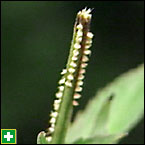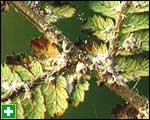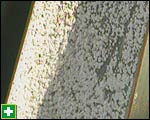My first assignment in organic pest management is to create a management plan.
My Pest Story:
I discovered a pest that is in abundance in my garden by first mistaking it's identity. I was making the cabbage tree tidy pulling off the dead leaves on the trunk when I spied what I thought could have been the cabbage tree looper Epiphyryne verriculata. I didn't want to upset an indigenous insect for the sake of a tidier looking cabbage tree, so I headed inside to look up "Butterflies and Moths of NZ" by Brian Parkinson and Brian Patrick.No the looper didn't match what I was seeing. So my next action in identifying what I thought was a moth was to text the photo to the best friend you can have in identifying bugs, Ruud Kleinpaste, aka "The Bugman".
Ruud sent me back a reply saying that he could forgive my ignorance because of my southern background where I wouldn't have come across this pest that is abundant in Auckland, the sucking insect - the Passion Vine Hopper Scolypopa australis that also has the nickname "Fluffy Bums". This isn't an affectionate name rather it describes the look of the Passion Vine Hopper at its young nymph stage. As it latin name suggests this is an insect that arrived into New Zealand from Australia as far back as the 1870's and is found from Nelson upwards.
Ruud suggested I go online and learn about them and how to prevent an invasion of them again next summer. He stated there is little I can do about them at this stage. I would need to hunt them down next winter and destroy them at egg laying stage.
At our organic community garden I was photographing the bronze foliage of a striking red dahlia when a cloud of tiny insects rose from the surrounding plants. My other entomologist friend is Trevor Crosby at the gardens. I showed him the photo and he confirmed these too are Passion Vine Hoppers transitioning from nymph to adult. They were like tiny helicopters compared to larger delicate lacy wingspan of the adult hopper.
Isn't it always the way...once told of something's existence that previously I had not noticed, I began seeing these hoppers everywhere in my garden. They were coating the stems of my lime tree in a pot. Then I noticed they were in our broad leaf hedge Griselinia Griselinia littorals aka Kapuka, some leaves were sticky with the tell tale honeydew that sucking bugs create.
The question I have has this infestation been because of what looks like a fungal infection on the leaves or has the fungal infection come along because of the Passion Vine Hopper.
Passion Vine Hopper Management Plan:
- Observed the adult hopper and initially thought it a native bug that I should protect
- Got correct identification and realised the potential damage that this bug could do to not only passion vines but other plants in the garden through reading up on it online.
- Observed this hopper was not only on the original plant but had infested a lime tree, and Griselinia hedge. Began seeing the adults and nymph's everywhere!
- From research realised I couldn't do much about them until winter (however have squatted a number of adults on the windows).
- Noticed the Griselinia had a big infection of hoppers at the Fluffy Bum stage as well as adults - question was the plant so weakened by the hoppers that it succumbed to a fungal disease.
- Immediate action for the lime tree and the Griselinia was to water well, then add Pacific Bio Fert to give the plants strength to fight the fungal disease, then water in EM (Effective Microbes) to inoculate the soil with microbes that may fight and counter disease.
- From March to October I need to ensure I hunt out evidence of eggs being laid on twigs of host plant. The eggs have fluffy tuffs that make them easy to identify (see below) Cut and burn or destroy wood and not put through compost.

Photo of plant stem with eggs of Passion Vine Hopper
 |
| Photo of plant stem with eggs of Passion Vine Hopper |
Online information:
Passion Vine Hopper: Prune twiggy dead material from garden in winter (eggs appear as tiny bumps on twigs), then burn or hot compost. Spray insects directly with neem or pyrethrum if you already have an invasion. "Pull a Swiftie on Pests" by Meg Liptrip http://www.nzherald.co.nz/lifestyle/news/article.cfm?c_id=6&objectid=10788373
Passionvine Hoppers are a sap sucking bug. They
cause a lot of damage, and are very difficult to
spray. Take ten minutes to read about their
lifecycle, and you will see that these Aussie imports
hatch in spring as tiny, jumping nymphs, and by late
summer they have grown lacey wings - now they fly
as well as jump! However, from March to October
they are laying very still in their eggs. Find them in
the thin twigs and tendrils of the host plant. They
are very obvious. The eggs are laid in lines – the
tufts of plant fibre give them away. Snip them out
and feel very clever as you burn them! http://www.huttcity.govt.nz/Documents/brochures/Summer%20pests.pdf
Passionvine Hoppers

Passionvine hoppers are tiny moth-like insects with mottled wings that suck the sap from plants and cause your plant to lose its vigour. They can also cause honeydew and sooty mould.
They overwinter by laying eggs, so you can stop the cycle by finding and destroying their eggs and eliminating egg-laying sites such as tendrils, thin woody twigs and dying stems.(RNZIH Winterbugs Rudd Kleinpaste)
SUCKERS
Think of a digger. The way it drills into the soil is similar to the way suckers drill into plants. If the digger were to hit a water main, it would be exactly the way the sucking insects find their food. Suckers stick their mouthparts into the phloem of the plant and extract the sweet plant sap within.
 Suckers excrete most of that sweet stuff as honeydew, which is eagerly harvested by ants. If you see a heap of ants going all over your plants, you know that a sucker must be at work, such as aphids on the underside of the leaves.
Suckers excrete most of that sweet stuff as honeydew, which is eagerly harvested by ants. If you see a heap of ants going all over your plants, you know that a sucker must be at work, such as aphids on the underside of the leaves.
Excess honeydew is a brilliant breeding ground for sooty mould. Here's a good infestation of mealy bug, causing sooty mould all over the place, including the bricks.
 This is a good example of massive numbers of suckers hammering the flax. They are scale insects and they are nicking all the sweet sap, causing local deficiencies in the leaves (discolouring of leaves). You see, that sweet sap is normally used for plant growth, including leaves, and the flax is suffering.
This is a good example of massive numbers of suckers hammering the flax. They are scale insects and they are nicking all the sweet sap, causing local deficiencies in the leaves (discolouring of leaves). You see, that sweet sap is normally used for plant growth, including leaves, and the flax is suffering.
Most suckers like aphids, scale insects, mealy bug, passionvine hopper, whitefly and green vegetable bug are like flying hypodermic needles, and that means they can spread diseases, especially viruses. That can be very serious for the health of the plant.
General chemical control of sucking insects would be systemic insecticides such as Orthene or Target. With scale insects and mealy bugs, use mineral oil or mineral oil mixed with insecticide. Organic control of most suckers can be achieved with oil, fatty acids or Pyrethrum. (RNZIH Bug Detection Ruud Kleinpaste)
Passionvine Hoppers

Passionvine hoppers are tiny moth-like insects with mottled wings that suck the sap from plants and cause your plant to lose its vigour. They can also cause honeydew and sooty mould.
They overwinter by laying eggs, so you can stop the cycle by finding and destroying their eggs and eliminating egg-laying sites such as tendrils, thin woody twigs and dying stems.(RNZIH Winterbugs Rudd Kleinpaste)
SUCKERS
Think of a digger. The way it drills into the soil is similar to the way suckers drill into plants. If the digger were to hit a water main, it would be exactly the way the sucking insects find their food. Suckers stick their mouthparts into the phloem of the plant and extract the sweet plant sap within.
 Suckers excrete most of that sweet stuff as honeydew, which is eagerly harvested by ants. If you see a heap of ants going all over your plants, you know that a sucker must be at work, such as aphids on the underside of the leaves.
Suckers excrete most of that sweet stuff as honeydew, which is eagerly harvested by ants. If you see a heap of ants going all over your plants, you know that a sucker must be at work, such as aphids on the underside of the leaves. Excess honeydew is a brilliant breeding ground for sooty mould. Here's a good infestation of mealy bug, causing sooty mould all over the place, including the bricks.
 This is a good example of massive numbers of suckers hammering the flax. They are scale insects and they are nicking all the sweet sap, causing local deficiencies in the leaves (discolouring of leaves). You see, that sweet sap is normally used for plant growth, including leaves, and the flax is suffering.
This is a good example of massive numbers of suckers hammering the flax. They are scale insects and they are nicking all the sweet sap, causing local deficiencies in the leaves (discolouring of leaves). You see, that sweet sap is normally used for plant growth, including leaves, and the flax is suffering. Most suckers like aphids, scale insects, mealy bug, passionvine hopper, whitefly and green vegetable bug are like flying hypodermic needles, and that means they can spread diseases, especially viruses. That can be very serious for the health of the plant.
General chemical control of sucking insects would be systemic insecticides such as Orthene or Target. With scale insects and mealy bugs, use mineral oil or mineral oil mixed with insecticide. Organic control of most suckers can be achieved with oil, fatty acids or Pyrethrum. (RNZIH Bug Detection Ruud Kleinpaste)
If you look at the tendrils of climbing plants (or any thin, woody twiggy stalks) you’ll notice regularly placed fluffy extrusions; each one represents an egg-laying site for passionvine hoppers. Get rid of them all and you’ll start the season with millions fewer fluffybums. http://www.earthcarenz.co.nz/news/latest-news/21-winter-is-still-good-for-gardening





